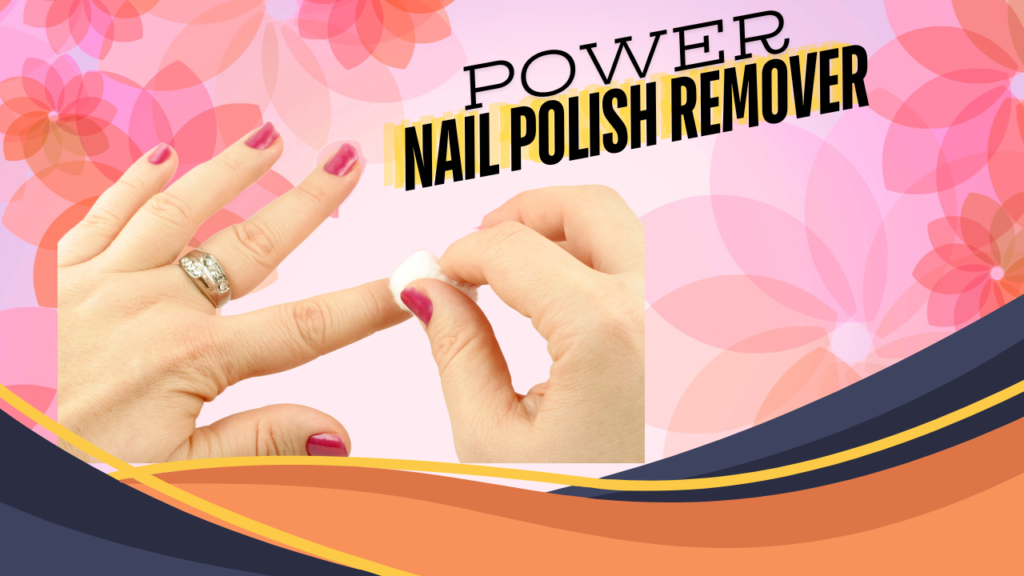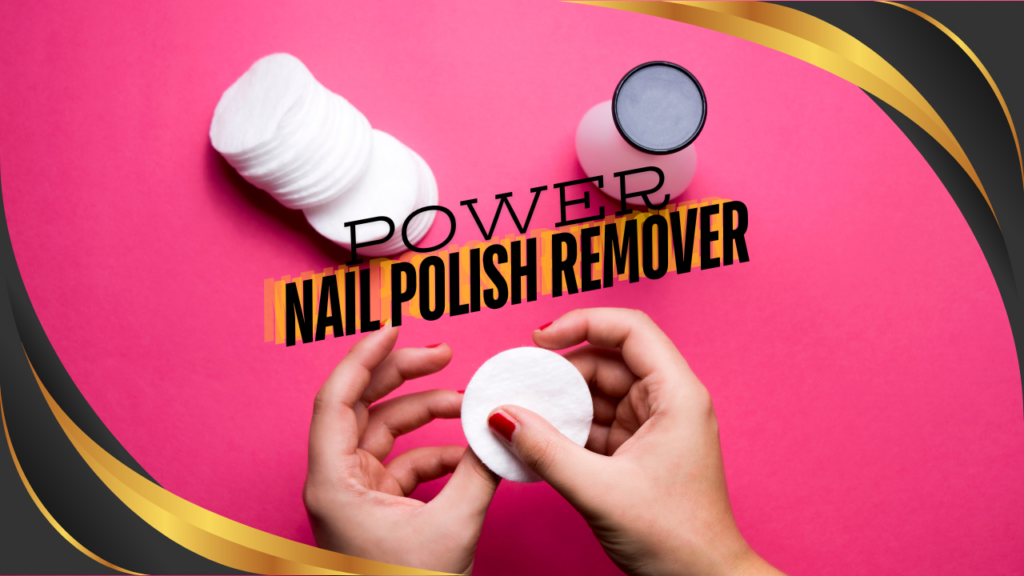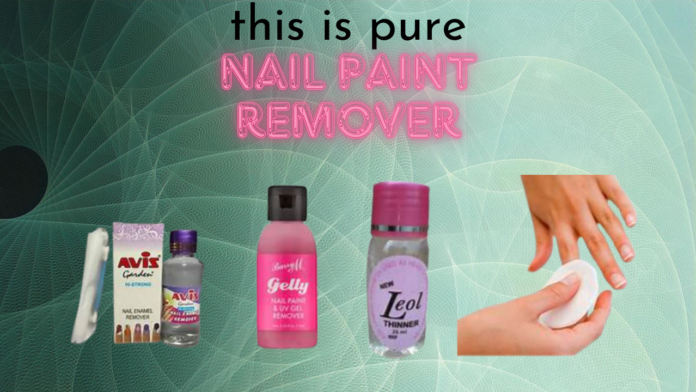What is paint remover and how to use ?
Nail paint remover is a liquid used to remove nail polish from nails. It works by dissolving the polish, allowing it to be wiped away easily. Here is more detailed information about nail polish removers:
Types of nail paint removers
1. Acetone-based remover
Description: Contains acetone, a strong solvent that effectively dissolves nail paint.
Pros: Works quickly and is effective on all types of nail paint, including glitter and long-lasting formulas.
Cons: Can make nails and surrounding skin very dry and hard. Strong odor may be unpleasant to some people.
2.Non-acetone remover
Description: Contains alternative solvents such as ethyl acetate, isopropyl alcohol, or other less harsh chemicals.
Pros: Gentle on nails and skin, has a mild odor. Less likely to cause excessive dryness.
Disadvantages: May be less effective on stubborn or heavy polishes such as glitter or gel.
Gel Nail paint Remover

Description: Specially formulated to remove gel nail paint, often containing strong solvents or additional ingredients to break down the gel.
Advantages: Designed to effectively dissolve gel polish, which is more resistant to regular removers.
Disadvantages: Not suitable for regular nail polish and can be more expensive.
3. Natural or Homemade Remover
Description: Uses natural ingredients such as lemon juice or vinegar to remove polish.
Advantages: Less harsh and more environmentally friendly. Can be gentle on sensitive skin.
Disadvantages: Less effective on tough or long-lasting polish and may require more effort to use.
How Nail Polish Remover Works
Dissolving polish: Nail paint remover works by breaking down the chemical structure of nail paint. The solvent in the remover interacts with the polish, causing it to dissolve and be removed from the nail surface.
Application: It is usually applied using a cotton pad or ball, which is pressed onto the nail to soak up and dissolve the polish. The polish is then wiped away, often requiring multiple applications for stubborn polish.
4. Use Instructions
Soak the cotton pad: Apply a generous amount of the remover to the cotton pad or ball.
Press and hold: Place the soaked pad on the nail and press gently for a few seconds to allow the remover to dissolve the polish.
Wipe: Wipe the nail paint away in one go, repeating if necessary. For tougher polishes, you may need to leave the pad on a little longer.
Wash hands: After removing polish, wash your hands to remove any residue and apply a moisturizer to keep your nails and skin hydrated.
5. Considerations
Skin sensitivity: Regular use of nail polish remover can cause dryness or irritation. Using non-acetone removers or natural alternatives may help reduce these effects.
Ventilation: Use nail paint remover in a well-ventilated area to avoid inhaling fumes, especially with acetone-based removers.
Overall, nail polish remover is an essential product for anyone who uses nail polish, providing a simple and effective way to remove or change the color of nails.
How to use:
Soak nails: Soak your nails in a natural remover for a few minutes.
Wipe: Use a cotton pad or ball to wipe away the nail polish.
Repeat: You may need to repeat the process or work a little harder to get all the polish off.
Moisturize: Wash hands and apply moisturizer.
Tips for using nail paint remover
Ventilation: Use nail paint remover in a well-ventilated area to avoid inhaling fumes.
Avoid skin contact: Try to avoid getting the remover on your skin, as it can be drying.
Moisturise: Nail paint remover can be drying, so always moisturise your hands and nails after use.
Check the ingredients: If you have sensitive skin or nails, check the ingredients of the remover to avoid any potential irritation.
Different types of removers are suitable for different needs, so choose one based on the type of nail polish you are removing and your personal preference.
Does non acetone nail polish remover work?
Yes, non-acetone nail paint remover works, although its effectiveness can vary depending on the type of polish you’re removing and the specific formula of the remover. Here’s a closer look at how non-acetone removers work: Effectiveness Regular nail paint Non-acetone removers are generally effective for removing standard nail paint. They can break down and dissolve most types of non-gel nail paint.
Glittery and tough polish: Removing glitter or heavily pigmented nail paint with a non-acetone remover may require a little more effort. You may have to soak the cotton pad longer or use more remover.

Gel nail polish: Non-acetone removers are not effective for removing gel nail paint. Gel polish requires special gel removers that contain stronger solvents.
Benefits of non-acetone removers Less drying: Non-acetone removers are generally less harsh and drying than acetone-based removers. This makes them gentle on the nails and surrounding skin.
Mild odor: These generally have a milder odor than acetone-based removers, which can be more pleasant to use.
How to use non-acetone removers Soak a cotton pad: Apply a generous amount of non-acetone remover to a cotton pad or ball.
Press and hold: Place the pad on the nail and press gently for a few seconds to help the remover break up the polish.
Wipe: Wipe the polish off with the cotton pad, repeating if necessary. You may need to apply more remover or use some extra effort for stubborn polish.
Wash hands: After removing polish, wash your hands to remove any residue and apply moisturizer to keep your nails and skin hydrated.
Considerations Time and effort: Non-acetone removers may take a little longer to work than acetone-based removers, and you may need to use more product.
Product quality: Effectiveness can also depend on the quality and formulation of the non-acetone remover you’re using. Some products are designed to dissolve polish more effectively and quickly. Overall, if you’re looking for a less aggressive solution that’s more gentle on your nails and skin, non-acetone nail paint remover is a good option, especially if you have sensitive skin or nails.
What is the advantage of the nail paint remover?
Nail polish remover offers many advantages, making it an essential product for maintaining and replacing nail paint. Here are some of the key benefits:
1.Easy nail paint removal
Efficiency: Nail polish remover quickly dissolves and removes nail paint, making it easy to change colors or clean polish off of nails.
Versatility: It works on a variety of nail polish types, including standard, glitter, and gel formulas (with the proper remover).
2. Maintenance of nail health
Prevents build-up: Regularly removing old polish prevents the build-up of multiple layers of polish, which can affect the health and appearance of your nails.
Nail care: Removing polish allows you to treat and care for your nails and cuticles without the interference of old polish.
3. Facilitates new applications
Preparation: Removing old polish ensures a clean and smooth surface for applying new nail polish, which can help achieve a more uniform and professional-looking manicure.
4. Clean and polished look
Aesthetic appeal: Nail polish remover helps maintain a clean and tidy look, especially if you want to change the color of your nails or correct any mistakes made from previous use.
5.Convenience and accessibility
Ease of use: Nail polish remover is easy to use and is readily available in different forms (liquid, pads, etc.), making it convenient for manicures and pedicures at home.
Variety: There are different types of removers (acetone-based, non-acetone, gel removers) available to meet different needs and preferences.
6. Helps protect nails from damage
Prevents chipping: Regularly removing old polish can help prevent chipping and peeling that can occur with old or damaged polish.
Nail health: This allows you to give your nails a rest from polish, which can help maintain their natural strength and health.
7. Cost-effective
Affordable: Nail polish removers are generally inexpensive and are a cost-effective solution for maintaining manicures and pedicures.
8. Customizable care
Gentle formulations: Non-acetone and natural removers offer gentle options for those with sensitive skin or nails, allowing for more customized nail care.
Overall, nail polish remover is a practical tool for maintaining and replacing nail polish, promoting nail health, and ensuring a clean and polished appearance.
What is disadvanteges of the nail polish remover?
Nail polish remover has many benefits, but it also has some disadvantages to consider:
1. Drying effect on nails and skin
Dryness: Many nail polish removers, especially acetone-based ones, can be very drying. They can remove moisture from your nails and surrounding skin, causing dryness, peeling, or cracking.
Potential irritation: Frequent use can cause irritation or sensitivity, especially for those with delicate or already compromised skin.
2. Harsh chemicals
Acetone: Acetone, a common ingredient in many removers, is a powerful solvent that can be harsh on your nails and skin. It can also contribute to weakening your nails over time.
Fumes: The strong smell of acetone and other solvents can be unpleasant and cause respiratory irritation in poorly ventilated areas.
3. Potential for allergic reactions
Allergic reactions: Some individuals may experience allergies or sensitivities to the chemicals in nail polish removers, causing redness, itching, or swelling.
4. Effects on the environment
Chemical disposal: The chemicals in nail polish removers can be harmful to the environment if not disposed of properly. If they are flushed down drains or disposed of irresponsibly, they can contribute to pollution.
5. Damage to natural nails
Weak nails: Using nail polish removers too frequently can weaken nails, making them more prone to cracking, chipping, or breaking.
Effects on nail health: Removing polish too often or using harsh removers can negatively affect the health and appearance of your nails over time.
6. Incompatibility with certain polishes
Gel and shellac: Standard nail paint removers may not be effective for removing gel or shellac polishes, which require special removers or professional treatments.
7. Cost of special removers
Special products: To remove gel or other special polishes, you may need to purchase specific removers, which can be more expensive than standard options.
8. Stains or residue
Residual effects: Some removers, especially those with strong solvents, can leave residue or temporarily discolor nails or skin.
Tips to minimize damage
Use non-acetone removers: Choose non-acetone or natural removers to minimize drying effects and irritation.
Moisturize: Always moisturize your nails and hands after using nail paint remover to relieve dryness.
Ventilation: Use removers in well-ventilated areas to minimize inhalation of fumes.
Limit use: Avoid excessive use of nail polish remover to prevent damage to your nails and skin.
By being aware of these disadvantages and taking steps to minimize them, you can enjoy the benefits of nail polish remover while minimizing the potential negative effects.
FAQs nail paint remover?
Here are some frequently asked questions (FAQs) about nail polish remover:
1. What is nail polish remover?
Nail paint remover is a liquid used to dissolve and remove nail paint from nails. It contains solvents that break down the polish, making it easier to wipe off.
2. What are the different types of nail polish remover?
Acetone-based remover: Contains acetone, a strong solvent for removing all types of nail paint, including glitter and gel.
Non-acetone remover: Use alternative solvents such as ethyl acetate or isopropyl alcohol. They are gentle on nails and skin but may be less effective on stubborn polish.
Gel nail paint remover: Specifically designed to remove gel nail paint, which often requires a soaking or wrapping process.
Natural or homemade remover: Made from natural ingredients like lemon juice or vinegar, usually gentle but less effective on tough polish.
3. How do I use nail paint remover?
Soak a cotton pad: Apply a small amount of remover to a cotton pad or ball.
Press and hold: Place the pad on the nail and hold it there for a few seconds to dissolve the polish.
Wipe: Remove the nail paint by wiping it off, repeating if necessary. For stubborn polish, you may need to leave the pad on longer.
Wash hands: After removal, wash your hands to remove any residue and apply moisturizer.
4. Can I use nail paint remover on sensitive skin?
Non-acetone removers are generally better for sensitive skin, as they are less harsh and drying. If you have very sensitive skin, consider using a natural remover or applying moisturizer frequently.
5. Is nail polish remover safe for my nails?
Generally safe: Nail paint remover is safe for most people when used as directed. However, frequent use, especially of acetone-based removers, can dry and damage nails.
Moisturize: To counteract the drying effects,



Your article helped me a lot, is there any more related content? Thanks!
Thank you so much for read my ariticals.